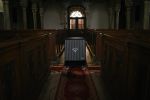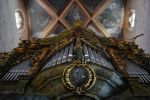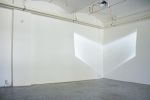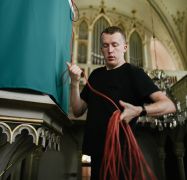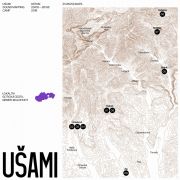The Gothic Route is an almost 300-kilometer path that connects historically interesting localities of the Gemer and Spiš region in Central and South Slovakia. The art group Skupina, together with Ladislav Mirvald, realized in 2018 a series of sound mappings that explored soundscapes and the relationship between ecology and aesthetics. —Editor’s note
(First layer)
In August 2018, together with sound engineer Ladislav Mirvald and the mappa music label, we realised a series of sound mappings of selected churches situated on the Gothic Route in southern Slovakia, working under the auspices of the residency series UŠAMI: Sound mapping camp. The Gothic Route connects cultural and historical heritage from the regions of Gemer, Spiš and Malohont. In the past, these places were important centres of art and crafts in Central Europe due their rich mineral deposits and deposits of non-ferrous metals and iron. Natural resources and mining created the social and economic conditions for the development of arts, crafts and education in these regions. Their economic prosperity during the Gothic period significantly contributed to the expansion of their cultural life. Thanks to the iron trade, these areas became a crossroads of many artistic directions, especially from Italy. With the rise of mining and metallurgy, the regions quickly became wealthy and this can be seen on the local Gothic churches, which display artistically rich paintings and artefacts. At the time, churches were important centers for cultural exchange. This does not correspond to their current image. The buildings have lost their social and cultural status, which is also reflected in their physical condition.
How does the space change if I consider it in the terms of sound, the forms it takes and its relevance? In a society that prefers to see rather than hear, where the eye is understood as the most important sense-organ for collecting information, can the shift in attention from seeing to hearing provide new approaches to perceiving the everyday social reality? Unlike visual perception, hearing cannot be reduced to a specific item. The listening experience always takes place in a space in which it interacts with the acoustic world surrounding it. When I listen to loud music on headphones while walking through the city, it is the sonic spectrum around my headphones that keeps me informed about the passing tram or car. Despite the isolation of the headphones, the reproduced music comes into direct contact with the space outside them. The sound manifests itself as vibration, a dynamic relation between the external and the internal, mediated through the ear and it allows external phenomena to get into the body and provide information. The sound that travels from its source into my body passes through a series of events between the object, the subject and the space between them. This provides a sense of presence and transmits a variety of information about the sound source and the space in which it travels. Information transmitted sonically contains a psychological and emotional message. This forms an environment for creating relations (LaBelle, 2009). Sound is a register of temporary exchanges, experiences and sharing.
The relation between the sound and the space become the subject of interest for mapping selected localities of the Gothic Route. We focused our attention on representative objects located within the route. The aim was to reflect the place’s current state and its relation to the past, rather than creating an exact analysis of the sound environment of select places. For this reason, three churches were selected as objects representing the region’s past. The mapped churches consisted of: The Gothic Protestant Church in Štítnik from the 14th and 15th century; the late Gothic Protestant Church in Dobšíná from the end of the 15th century; and the rural Protestant Church in Brdárka with Gothic and Renaissance elements from the late 17th century. During the scouting process, we took into account the buildings’ locations — the structures should stand outside the industrialised parts of the country, isolated from motorways, factories, airports and other sources of anthropogenic sounds. The selection of the mapped churches forms a compromise based on location of the spaces, their accessibility and their cultural and historical importance.
The church in Štítnik is situated in the middle of a small village. The church in Dobšíná is located near the centre of the former mining town. Both churches are located in the valleys between the national park Slovakian Karst and Slovakian Paradise mountain range. These two churches are still active and regularly host religious ceremonies. The final mapped church was in Brdárka. The village stands on the outskirts, in isolation, on the slopes of the mountain Veľký Radzim in the north-eastern part of the Revúcka Highlands, and is home to around seventy inhabitants. The Brdárka church is also active, but the religious ceremonies take place irregularly and only during important Christian holidays. This church will be used in the following text to describe the theoretical background, motivations and methods of the sound interventions. We stayed in each of the mapped churches for two to three days, depending on the character and difficulty of production and logistics of the project. The interventions took place always during night and in the early morning hours. The sound environment of the night landscape is quieter, with no excessive acoustic pollution caused by the air transport and traffic. Sonic events, musical or others, cannot be isolated from the spatial conditions of their physical transmission. Night interventions provided more acoustically attractive situations for mapping and working with sound in order to capture the sonic environment without sonic situations caused by the mechanics of the anthropogenic world.
(Second layer)
Brdárka is a small village located in a valley in the Revúca Highlands. The village has no railway connection and only one dirt road leads to it, which also ends there. This is the only official road for supplying around forty houses in the village. The countryside around is surrounded by meadows, pastures and hilly forest terrain. The village location and its isolation from the industrialised land makes its sound environment well protected from the noises of the anthropogenic world. The local soundscape consists mainly of sounds typical for the climate and geographical location of Brdárka. The soundscape of the daytime is shaped mostly by the sounds of surrounding forests and pastures, birds, insects and a flock of sheep from a nearby farm. The dominant feature of the night soundscape is silence defined by the isolation of the surrounding hills, disturbed only by the pervasive singing of crickets from the nearby meadows.1 These sounds represent the fundamental sonic spectrum which has archetypal significance for the place. Despite the fact that the sounds created by the surrounding landscape may not always be consciously perceived, they are constantly present and thus it is not possible to ignore their significance. They affect human behaviour and the possible absence of them can result in a behavioural and organisational change for people who listen to them. These sounds allow defining the nature of the individual and the society living in such an environment (Schafer, 1994).
At the forefront of the ambience created by the landscape, there appear sound signals made by man and his activity, which are consciously heard and mediate symbolic values. They are often organised into logical codes offering meaning to those who can interpret them. Such a code was the sound of church bells from the village’s protestant church, built in 1696 on the site of a former wooden church. The construction is a typical example of a simple rural church with Renaissance and Baroque elements, which was later extended by a bell tower, wooden altar with spiral columns and a cornice fitted with angel figures, and a moulding with gilded plaster acanthus ornaments. The church has a longitudinal central nave with a floor of quarried stone and a wooden triforium on carved pillars on which stands a pipe organ.
The sound environment of the past rural landscape was quiet and calm, the most significant acoustic manifestation being the sound of the sacred space. At the time of its origins the church represented an important institution for the organisation and formation of everyday life in the village and its surroundings. The church parish was an acoustic space that was created and bounded by the sonic horizon of the bell tower. It represented a medium which through the sound of ringing bells informed the community about activities of the religious institution and the community it served, as well as about possible threats and dangers. Church bells are a significant acoustic symbol of Christian life. Their sounds are an important communication tool. The symbolic experience of listening to the church bells is shaped subjectively, depending on the hearing capacity and the psychological, cultural and social background of the listener. There is no universal approach to the listening process, and each culture listens in its own way (Augoyard and Torgue, 2005). In Christianity, the divine is signalled by the sound of a sacred place — the church, which is the formation place of religious identity (Kvíčalová, 2019). The sacral was shared not only by the voice of the preachers, prayers and songs of the faithful and the sound of the pipe organ, but also by the loudest instrument of that time, the church bell, all in order to lead to the listening to the sacred. Sound was not perceived only as a background of religious life, but as an active factor that mediated and organised social events. Bell-ringing announced religious ceremonies, deaths, weddings, time and weather changes and threats of war. The sound of bells co-creates and organises the social life in the village and its surroundings. The church bell has a centripetal acoustic quality, uniting and connecting the community on a social level in the same way that it unites and connects the individual with the sacred.
In many regions, it was customary to ring the bells in honour of the arrival of ecclesiastical authority. Ringing as a symbol of honour became attractive even outside of the religious hierarchies, as when the bell rang in favour of local nobility. This act was legitimized through sponsorship and co-financing of the bell’s production, where the cast relief on the bell often contains the name of such person or a phrase representing the title of the nobility and its relation to God. In an age when people believe that the sound of the bells and bell bronze has purifying qualities and can invite angels to participate on the prayers or chase away demons causing plague and episodic disasters such as bad harvest and droughts, ringing in honour of an individual or family was a welcoming mechanism for the power structure (Corbin, 2004). Thus, the church bells reinforced existing social divisions. At a time when the church was one of the primary sources of information and one of the establishments creating social structures, sound was used as a political tool.
The sound of the bell was also a tool for sharing information, as well as a qualitative indicator of time. At the time that the mapped churches came into being, time was not understood as a continuous and measurable flow of unique intervals as it is today. The mechanical clocks were a luxurious artefact which were not available to everyone. Bell-ringing announced only a few special moments within the day, week and year. The bell was a tool for measuring qualitative time; an acoustic calendar. The Sunday act of dressing up and then attending the Christian ceremony was organised by the sound of the bells. The sonic perception of measurable time was firmly in the hands of those who had access to the church bells. The bell as a time indicator had the advantage over mechanical clocks by the fact that it was not necessary to look at it directly. The bell emits acoustic pressure that spreads evenly in all directions, the one type of sound that regularly resonated above the sound spectrum and organised the life of the community. The association of the bells with time was not accidental. In the Christian tradition, ringing in the regular intervals was associated with understanding time clerically by its sacralization, where the bell indicates the beginning of the day (the creation of the world and light), regular calls for prayer (as an indicator of Christ) and the end of the day (the end of light, the apocalypse). In the 7th century, Pope Sabinian decided that monastery bells should ring seven times a day, which later defined the canonical hours (Schafer, 1994). In the life of a Christian community the acoustic signal defined by the bell represented a continuous rhythm in the daily activities, which gave qualitative properties to time.
In addition to liturgical and canonical contents, bell-ringing served to inform about imminent dangers such as fires or weather changes, as well as about community and social events. In everyday life, the acoustic signals of the bells called the community to devotion, mourning, joy, or warned of impending danger. The difference between various ways of ringing and the values they indicated was generally known. No matter how intense the religious belief was, the sound of the bells symbolically represented the institution organising the local community (Corbin, 1998). The bells formed a culture of the senses and the community’s habitus. The emotional impact of the ringing bells formed a sense for territorial identity based on affiliation with the local religious organisation and its community. While the sound was to be heard throughout specific territories, the sound of the bells became a tool for constructing and structuring space.
Beyond the sacral and social content, sound was used as a tool for navigation in space, specifically in highland and coastal areas. The sound of the bells allowed finding the right direction for wandering traveller. In the coastlands with no lighthouses, the bell sound was one of the tools of navigation. Bell ringing framed the space by defining the sonic horizon of home. The sound of the bells was one of the greatest sonic events for the rural population in their civil life (Corbin, 1998).
The mapped churches were built between the 14th and the 17th centuries, during a time with no acoustic pollution, when the sonic landscape was not disturbed by the sound of industrialised society and the anthropogenic world. The symbolic meaning of the auditory signals has changed and the sound of the bells gradually became desacralized. The mapped objects still fulfil their religious role, but radical change in the rhythms of everyday life, habits and culture of the senses raises the question of how to conserve the historical significance of these sounds. For the current time it is difficult to grasp the complexity of meanings of the bell sound and its impact on the social reality of an individual and their community. The sound helped to localize one in space and time and defined the social structures in which the life of an individual and community took place. In the rural country, the sound of the bells was an important tool for mass communication. Learning the original meanings and what the sacral sound, defined in the everyday social reality of the past, provided the basis for designing the sound interventions. The aim was not to reconstruct their previous meanings, but to critically reflect their current condition; to present the state in which the original meanings changed or were transformed. The church as a physical object has remained, but its symbolic values have been deconstructed. The secular mythologies that shaped the social reality has become quiet. Factors that formed the ideas, structures and hierarchies have disappeared. The only thing left is the physical substance, space itself. How can we reflect a situation in which the sound of transmitted messages has lost its original meaning, and what is the role of the space in which the sound resonated? The method of intervention, which was based on the compositional practices of avant-garde music, was subordinated to this.
(Third layer)
In the late 1960s, composer Alvin Lucier left conventional musical instruments, as many of his colleagues did at that time, and sought inspiration outside of the framework of traditional composition. Lucier started to think of sound as a measurable wavelength. This turn symbolises a radical change in thinking about musical composition and its relation to physical space. The wavelength, as a distance between repeated wave intervals, enables one to get a functional image of the space by travelling through, passing through and rebounding from the objects situated within the space. Using simple noises that Lucier had reproduced in various spaces allowed the place and its architectural solution to participate on the sonic experience. The intention of such composed works was to draw attention to the space itself and its exploration using one's own hearing (Lucier, 1995). This interest has spread from the two-dimensional tradition into the three-dimensional world.2
One of the important aspects of capturing the physical world is to listen to it. This experience can provide information on its size and used materials. When the possibility to hear the space is not available, one can feel isolated and disoriented. It is common practice of sound technicians to clap in the room before they set up. The invoked echo can provide information about the room’s acoustic character, the distances, materials used and resonators in the space. Despite space itself not being the source of sound, it can manifest its presence.
In 1969, Alvin Lucier presented one of his key works, I am Sitting in a Room, composed for space, human voice and tape. In it, Lucier reads the following text into a microphone placed in the room where the piece is performed. The text reads as follows:
“I am sitting in a room different from the one you are in now. I am recording the sound of my speaking voice and I am going to play it back into the room again and again until the resonant frequencies of the room reinforce themselves so that any semblance of my speech, with perhaps the exception of rhythm, is destroyed. What you will hear, then, are the natural resonant frequencies of the room articulated by speech. I regard this activity not so much as a demonstration of a physical fact, but more as a way to smooth out any irregularities my speech might have.” 3
The performance corresponds to its description, the voice was recorded on a tape and played back into the room. The piece proceeded in a loop: voice leaves the body – microphone – recorder – amplifier – speaker – space – microphone – recorder - … This process was repeated several times. With each layer, Lucier’s voice disintegrated compared with the original recording. This process can be repeated as long as the performer finds interest in it. During the first realisation of the composition, Lucier repeated the loop fifteen times. Later, in 1981, the cycle was repeated 32 times for the purpose of making a record. During the 45 minutes of the recording, Lucier’s voice and its imperfections gradually become absorbed by the space. After ten repetitions, the speech imperfections are smoothed out and the voices, now turned into sharp, metallic sound, are pervaded by a long drone which deforms by the increasing number of repetitions. What begins as a first-person speech turns into anonymous sound absorbing the performer. The meaning and identity dissolve in the space (Cox, 2018).
The text addressed to the room is a practical description of the process. The descriptiveness is intentional. Poetic language and aestheticization of the text could lead to a shift in attention from the deconstruction of the sound to the meaning of the words being spoken. The sounds of the later layers represented the resonant frequencies of the room in which the piece was performed and recorded. I Am Sitting in a Room experiments with the fundamental principles of acoustic and resonant frequencies of a space in order to create music. What can be heard in the piece is the sound of transformation from iteration to iteration. As the resonant frequencies gradually become louder with each repetition of the process, they slowly erase the dominant position of the human performer. The specifics of speech become less recognizable with each new layer of the process. The sound of speech is replaced by the sound arising from the amplification of the resonant frequencies of the room. The speech has not stopped and was not replaced by the sound. The speech cadence, as well as its phonetic and syntactic structure, has remained (Kahn, 2009).
The composition points to the dynamic development of speech even when its intelligibility disappears with layers of repetition. For his compositions Lucier frequently used basic instruments, independent of the architectural dispositions of the space, with no need to use specific equipment for amplification. I Am Sitting in a Room is important for the way it works with the space in the context of musical composition. The main concept is to radically disprove the logic of musical structure. Instead of using traditional musical methods, Lucier used a technological process and the fundamental laws of acoustics. The music is here presented as a physical phenomenon that is material and provides a spatial experience, one where the architecture of the space is an inherent part of the piece. The aesthetics of the composition lie in their feasibility across spaces without any specific need of reciprocity or the resonant qualities of the space. The form varies depending on the variability of the space, the materials used, surfaces, humidity, weather conditions, temperature, the equipment used and on the objects located in the space. Each repetition has its own temporality, each is an original artefact with a unique relation to the time and space in which it sounds.
The evolution of the final form can vary from room to room, depending on the acoustics of the space. Frequencies that naturally resonates within the space can appear in the recording much later, depending on the place where the piece is performed. The recorded speech is amplified if its frequencies match with the resonant frequencies of the space. Resonance as an amplification or extension of the sound by its reflection from the surface is an important aspect of a sound’s transmission in space (Kelly, 2017). The discovery of the resonance frequencies of space can be achieved through a number of exact methods. As Lucier points out, in the process of making the composition he was not interested in the scientific origin of the resonances but rather in presenting the space as a substance that can be heard (Lucier, 1995). The process cannot be reduced only to a playback or recording system. I Am Sitting in a Room is a representation of a fundamental problem of communication. The transmission of a message at one point and its reception at another underlines the role of the space that acoustically modulates the sound and thus the broadcast information (Kahn, 2009). Lucier created a do-it-yourself modular system without the need to develop or manufacture a new instrument, nonetheless having the same impact. In this sense, the space becomes a modular system that allows information transduction between electromagnetic signal, the acoustics of the space and the recorder. The composition cannot be repeated without the use of amplification and recording technology and therefore its critical reflection is not possible without taking this into account. What is heard has not only been shaped by space and its elements, but also by the recording and amplifying technology and its features. In addition to the acoustic properties of the room, the recorder and playback system and their technological qualities also contribute on the resulting composition (Hainge, 2013).
Lucier's compositional practice of the late 1960s was based on the acceptance of space as a legitimate musical body capable of constructing complex meanings. This act has transformed the attitude towards musical composition from “what I can put into the room” to “what I can use the room for” (Kahn, 2013, 105).
(Fourth layer)
Looking at an image can evoke an immediate impression on the viewer. There is no element in sonography that can affect the viewer in the same way as an image. With the camera, it is possible to create an immediate impression by capturing the visual elements of the panorama. The audio recorder does not work this way. It can capture detail, but not in the same way as optics-based systems. The sound environment of the mapped churches consists of events that can be heard rather than seen. While from the visual materials it is possible to find out how the landscape has visually changed, the acoustic changes need to be traced in historical, anthropological and ethnographical research and literature (Schafer, 1994).
Rather than reflecting the conceptualisation of aural history or provide an exact description of the sounds of the past, the aim of the sound mapping in Brdárka, Dobšína and Štítnik was to give the space a voice. A voice able to present the current state of the space as resulting from historical, cultural and social changes. The aspects associated with the sonic environment did not consist only of the sounds themselves, but also of the living and non-living actors producing these sounds. The role of acoustic space is established by the society that perceives it. This makes it a discipline that is in a process of constant construction and change. What does it mean to hear a space? The sound can be described using musical terminology as rhythm, length, dynamics and tone colour, or by using spatial parameters such as distance, direction and location. When I start to understand a sound as a source of social information, the acoustic terrain changes into a symbolic space for communication. In the context of the mapped structures, the sound played an important role in the formation of cultural knowledge.
The church in Brdárka is a cultural form that allows its members to mediate the presence of God. In the interventions, the performative part is transferred from God to the object itself by using recording equipment, amplification and organised sound. A voice is given to the space in a way that is formally based on the compositional process of Lucier’s I Am Sitting in a Room. Unlike the original composition, it does not try to sound the space by human voice even though the voice was an important element of communication in sacral space. The sound mapping gives voice to the space itself without any sound input of the human performer. The intervention begins with the recording of silence, the ambience of the space disturbed only by the sounds of the surrounding night landscape. This recording is then played back into the space, recorded and the whole process in repeated several times.
The church has to be entered through massive wooden double doors in the bell tower, leading under the wooden triforium to the nave. The nave is lined with wooden pews that lead to a Baroque altar dating from 1795. Throughout the sound intervention, the triforium was used for the placement of the recording and monitoring equipment. The set for amplification was placed in line with the altar. The aim was to preserve the original acoustic disposition of the place where the sound was transmitted from the altar to the triforium and back, while following Lucier’s instructions in which sound is placed as far from its source as possible. The final form of the sound intervention was affected by the equipment used. Despite the fact that during the intervention each individual layer of the recording was cleared of the noise caused by the electroacoustic qualities of the equipment used, the spatial orientation of the recorder and loudspeakers played a part in the final composition. All the sounds that passed through this system, from the loudspeakers to the microphone, were acoustically processed by the physical qualities of the space and the objects placed within it. The wooden pews, triforium, stone paving, altar, pipe organ, recording equipment, their qualities and our bodies formed the final form of the piece.
The process was repeated nine times over the span of two nights. The technical and temporal complexity of the intervention did not allow us to repeat the process in a larger number of cycles. The original recording of silence gradually deformed during the several hours of recording and playing back to a continuous drone similar to the sound of Tibetan singing bowls. The clear and easily identified sound of the first layer turned into a blurred, 30-minute drone that took over the mapped space in its intensity and loudness. The past meanings disappeared in layers of noise. The space speaks, but it cannot be understood. The reverberations structure the space and the objects contained within it. This process does not change objects or spaces but puts them in a relation which creates an immersive experience. A connection is established where, on the one side is a sound source to which the other side responds by resonating, creating a spatial duet (LaBelle, 2009).
The final piece explores the sound, space and their relations, which creates an environment for the imagination. The church bells defined the cultural, social and religious framework of the territory in which it was possible to hear their sound. The previous meanings disappeared but the physical space remained and provided the base for the intervention liberated from the symbolic language of the past. This mapping disrupts the binary of the present — absent and the audible — inaudible. The results of the intervention were presented as a part of the UŠAMI CD compilation, and as a digital release on the Mappa label, published in 2019.4
At this point, is necessary to mention the difference between the experience of directly listening to soundscapes and listening mediated by mechanical reproduction. The auditory perception does not have to be different. The same perceptual apparatus is used to perceive both experiences. It has been too short a time since the invention of the audio recorder for the human body to develop a new mechanism of perception. However, the human body is well acquainted with the specific qualities of different communication media through their acceptance as tools of everyday reality (Ingold, 2007). The CD mediates the audio recording in three layers. As a recording of the space, as post-production and editing of the record, and as a recording affected by the medium used, the playback system and the space in which it sounds. Defining the levels of mediation of the audio CD provides a model for the structure of sound in relation to its perception within a medium (Chapman, 2017).
The recording of the sound intervention in Brdárka offers an accurate documentation of the sound experience, which is transmitted to the listener via an audio medium. The recorded sound has not been aesthetically modified in order to preserve the sonic experience as accurately as possible; to preserve the relation between the medium, the space and the listening body. The documentation of the intervention creates an independent existence of the place by its archiving. The audio recording offers a return to the space at the cost of separating the sound from its original source. However, I cannot understand the recorded sound as being necessarily disembodied, as the record replaced one body with another. The body of the sacral space is replaced by the body of the recording equipment, audio medium, CD player, amplifier, loudspeakers and the place where the sound is played. Without knowing the background and the context, technology speaks with the voice of the mapped object, over and over, even at the moment when the walls of the church turn to dust. It thus offers and archives an audio experience that escapes physicality.
Translation by Ján Solčáni. Originally published for Som Desorganizado 2020, an annual meeting on contemporary praxis in music, sound and theory organized by Sonoscopia.


